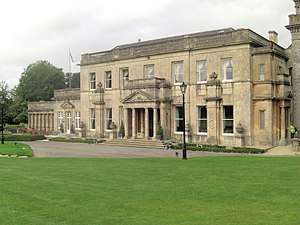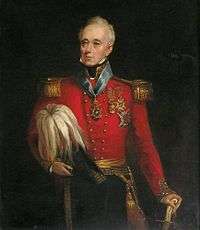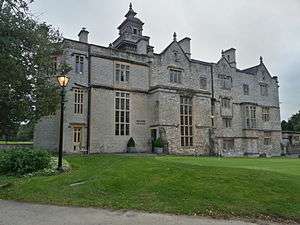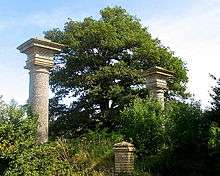Tracy Park
Tracy Park is an estate near Wick, South Gloucestershire, close to the boundary with Bath and North East Somerset and approximately 5 miles (8.0 km) from the World Heritage City of Bath. Set in approximately 240 acres (97 ha) of parkland, the house is a Grade II listed building.[1] It has a 17th-century nucleus behind a classical two-storey front built of Ashlar stone. The gate piers either side of the carriageway leading to the house are also Grade II listed.

The estate is documented from 1246. Throughout the 17th and most of the 18th centuries, the estate was owned by a succession of Bristol merchants and tradesmen, culminating in Robert Bush, a pewterer, who purchased the estate in 1774. His son, Robert, constructed a classical façade in c. 1800, obscuring much of the original building. Sold for more than £12,000 to General Sir William Gabriel Davy in 1820, it was much altered and rebuilt by his son, a prominent Freemason, who adorned the estate with many Masonic symbols. The estate again changed hands in 1926. The mansion ceased to be a private house in 1973, when it was auctioned and subsequently became a golf and country club and hotel.[2]
Early history
During the Roman occupation of Britain, a large villa was sited on what is today the Tracy park estate. It was excavated in 1865, when it was found that the villa had once been enclosed by earthworks encompassing some two acres of land.[3] Standing stones, thought to be the remains of a long barrow, just under a mile from the house, suggest that the site was occupied at an even earlier date.[3] The present site became the property of John de Tracye in 1246; the park probably constituted 100 acres of land at the bottom of Freezing Hill and his manor house was likely near the church and not in the park, although its exact location is unknown.[4] His descendants, Lords of the Manor of Doynton, held the property until the end of the 16th century.[5]

The estate was purchased from John de Tracye's descendants in 1595 by William Wintor, who likely built the house a few years later.[6] It was a small gabled building, known in the 17th century as Well House.[4] By 1718, it had a hall and kitchen and, in the 18th century, sat in a park comprising 200 acres of land.[4] The estate was owned by a succession of Bristol tradesmen, ending with Robert Bush, a successful Bristol pewterer, who purchased the house in 1774 for £6,250.[7] Bush's son, Robert, inherited the estate. Most traces of the 17th-century house were obscured when he rebuilt it and gave it a classical façade in c. 1800.[7][8] In 1820, Bush sold the estate to General Sir William Gabriel Davy (1780–1856) for £12,818,[9] and it was his son, Rev. Charles Raikes Davy (1819-1885), who after inheriting the estate from his father in 1856, was responsible for the size and appearance of the house and estate seen today.[10]
Charles Raikes Davy began a program of rebuilding the mansion in 1858; datestones bear the years 1858, 1859, 1863, 1864 and 1871.[3][9] He is thought to have commissioned the Bath architect John Elkington Gill to aggrandise the early 19th-century architecture.[9] Gill retained the western façade, but embellished the slightly projecting central three bays with an overpowering Doric tetrastyle porch.[11] It was during this rebuilding that two large pilasters were added to the western façade.[3] In keeping with the mid-Victorian fashion for housing the growing number of servants in a separate wing, Gill also designed the large south-eastern service wing; this was designed in a loose Tudor Gothic style, linked to the main house by a belvedere.[3] In addition to his work on the house, Davy was also responsible for building the dry-stone walls enclosing the property, and many of the estate buildings.[6]
As of 2015, the Tracy Park estate consists of approximately 240 acres (97 ha) of land.[12] Historically, the size varied: when sold by the Bush family in 1820, to William Davy, the estate consisted of just 120 acres (49 ha); nineteen years later, the estate was further reduced to 67 acres (27 ha), although it was expanded in the 19th century by Rev. Charles Raikes Davy.[6] A country estate until 1973, the Park is now a golf and country club and contains the Crown and Cromwell courses, each with 18 holes.[13]
Description
The north-west entrance to the estate is through two tall mid-19th century gate piers, which are Grade II listed.[14] These are constructed principally of rubble, but dressed with bath stone ashlar which frames heraldry peculiar to the Davy family. The piers are crowned by double cross finials.[3] These piers clearly reflect the unusual design of the large buttresses on the south face of the mansion. Opposite the entrance piers, and deliberately complementing them, is a three-story farmhouse built in about 1845; this has been given heavy Grecian detailing, a blind pediment and a classical balustrade to its precincts.[3] The southwest entrance is also through high gate piers, but these are cylindrical and of a simpler, chaste design than those of the northeast entrance.[3]

Tracy Park gives its name to the Grade II listed mansion situated within its grounds.[11] The house has a 17th-century nucleus, but has been remodelled externally. Its two-storey western façade of seven bays, in a classical style built of limestone ashlar, dates from circa 1800. The slightly protruding central three bays contain the main entrance which is through a later Doric tetrastyle porch; the tympanum within the porch's pediment contains a lamb and flag motif, while the entablature bears the motto "In hoc signo vinces."[11] Two large pilasters sit between the outer pairs of windows on either side of the facade; perhaps intended to complement the porch, they rise only to the first floor and are crowned with heavy stone crosses. This porch is part of the remodeling of the house by Charles Raikes Davy. On the western facade's left side is a single-story 19th century extension; it has a central door (beneath a pediment) between two windows. Attached to the left is a lower extension, dating to c. 1920, with an arcade of eight Doric columns.[11]
A 19th-century belvedere tower to the right of the house's western elevation links the main building to the service wing. It is described by Verey and Brookes as containing "over-elaborate Grecian detail."[3] The unusual design of the tower is very much in the style of the 19th-century architect Alexander Thomson. Classical Greek architecture did not feature towers, therefore the tower would have been the unknown architect's own interpretation and explain why the "Grecian" tower contains both Greek and provincial Italian elements - such a tower is a feature of Italianate architecture derived from the look-out and campanile towers of the Italian Renaissance. Tracy Park's tower has an upper-most floor, completely surrounded by a slightly projecting Italiante balcony, supported by corbels, appears as a rectangular cupola and has Ionic pilasters at each corner; this structure is surmounted with a large finial.[11]
Much of the rear facade of the house was remodeled in the 19th century in a Tudor Gothic style.[3] However, the haphazard fenestration suggesting mezzanine floors, and stonework and the need for a low buttress suggest that the lower floors, at least, may belong to the 16th and 17th-centuries. Facing the rear are a number of outbuildings, including the former stables, which date from 1849 to 1860.[3]
Freemasonry

Tracy Park contains symbols of Freemasonry and the associated Knights Templar; these date to the occupation of the house by Rev. Charles Raikes Davy, who inherited the estate in 1856 and died in 1885. An Anglican priest, educated at Balliol College, Oxford,[15][16] Davy was described in local newspaper reports as popular amongst Masonic groups in Gloucestershire due to his "devotion to the general interests of Masonry";[17] he was Grand Chaplain to the Grand Lodge of Freemasons and also Provincial Grand Master of Mark Masons for Gloucester.[15][16] He added extensively to the estate in the 1850s, 1860s and early 1870s.[3]
Amongst these additions are symbols associated with freemasonry: the cross of Lorraine finials crowning the main entrance piers;[3] the twin cylindrical gate piers at the south-west entrance[3] bear resemblance to the twin pillars, Boaz and Jachin;[18] and the deep engravings in an overmantel in what is now the hotel restaurant, described by English Heritage as "masonic emblems".[11] Other Masonic references include the motto "In hoc signo vinces" carved above the mansion's principal entrance, taken from the standard of a Commander of the Knights Templar.[19] On the south front are paneled twin buttresses, flanking the entrance and crowned with crosses, which seem to serve no structural purpose; they are possibly a further reference to the pillars of Boaz and Jachin. The lamb and flag motif carved into the pediment of the entrance porch is not only the crest of the Davy family, but also a symbol of the Knights Templar and Freemasonry.[20]
Modern history
Charles Raikes Davy died in 1885[10] and his son, William (1851−1915), inherited the estate.[21] The younger Davy moved to St Ann's in Burnham and, by 1897, Tracy Park was unoccupied.[22] After his death, the estate passed to his son, William James Davy, who had lived in the United States and Ceylon before joining the Ceylon Rifles at the outbreak of World War I; he fought with them in Gallipoli and France, but was killed in action in 1916.[23] After his death, the estate passed to his sister, Helen Hodges (later known as Mrs Arthington-Davy).[23][24]
In the family's absence, the house had been let from at least 1912 to Charles Samuel Clarke (1873−1947),[25] a director of the Imperial Tobacco Company,[26] who eventually bought the property from Helen Hodges in 1926. In July 1929, it was announced in The Times that the Davy heirlooms from Tracy Park were to be sold by Helen Arthington-Davy.[27]
The Clark family remained in occupation of Tracy Park until the death of Charles Clark's widow, Elsie, in 1973; the estate was then put up for auction, after which it became a golf and country club and hotel.[6] As a leisure complex, the estate was sold by Ian and Jane Knipe to TP Resorts in 2005;[28] they bought it back in 2010[28] and, as of 2014, the Club is owned by Knipe and his wife, Ann.[29]
As of 2015, the Tracy Park estate consists of approximately 240 acres (97 ha) of land.[12] Historically, the size varied: when sold by the Bush family in 1820, to William Davy, the estate consisted of just 120 acres (49 ha); nineteen years later, the estate was further reduced to 67 acres (27 ha), although it was expanded in the 19th century by Rev. Charles Raikes Davy (1819–1885).[6] A country estate until 1973, the Park is now a golf and country club and contains the Crown and Cromwell courses, each with 18 holes.[13]
References
Citations
- "Listed Buildings". English Heritage. Retrieved 23 February 2015.
- "Tracy Park". Domesday Reloaded. BBC. 1986. Retrieved 19 February 2015.
- Verey & Brooks 2002, p. 808.
- Kingsley 1991, p. 254.
- "Tracy Park (official site)". Retrieved 20 February 2015.
- "Deeds Relating to Tracy Park Estate". The National Archives. Retrieved 20 February 2015.
- Kingsley 1991, pp. 254–255.
- Verey & Brooks 2002, p. 807.
- Kingsley 1991, p. 255.
- "Charles Raikes Davy died on 25 December 1885, aged 67". The Times (issue 31644). 31 December 1885. p. 1.
- Historic England. "Tracy Park (1211440)". National Heritage List for England. Retrieved 22 February 2015.
- "Golf Membership". Tracy Park Golf & Country Hotel. Retrieved 23 February 2015.
- The Golf Guide Britain and Ireland. Hunter Publishing. 2005. p. 204. ISBN 978-1-588-43413-5.
- Historic England. "Pair of Gate Piers at Main Entrance to Tracey Park (1216149)". National Heritage List for England. Retrieved 22 February 2015.
- The Times (issue 31641). 28 December 1885. p. 4.
- The Times (issue 18438). 27 October 1843. p. 3.
- "Masonic Gathering at Cheltenham". Gloucester Citizen. 10 March 1879. p. 3.
- "King Solomon's Temple comes to Bristol". Retrieved 20 February 2015.
- Dafoe, Stephen A. "In Hoc Signo Vinces". Masonic Dictionary. Retrieved 23 February 2015.
- "Masonic Lamb". Masonic Lodge of Education. 26 January 2015. Retrieved 26 February 2015.
- "Death of Mr. William Davy". Bath Chronicle and Weekly Gazette. 6 February 1915. p. 2.
- "Dumbleton". Kelly's Directory of Gloucestershire. 1897. p. 141. Retrieved 23 February 2015.
- "The Late 2nd-Lieut. W. J. Davy". Western Daily Press. 8 November 1916. p. 5.
- Helen Arthington-Davy as Helen A Davy had married a Tom Hodges in 1919; she changed her name (along with that of her two sons, Tom Jeffrey and William Henry) by deed poll to Arthington-Davy in 1927. The Times (London, England), Thursday, 22 September 1927; p. 24; Issue 44693.
- "Shorthorn Society". Western Daily Press. 14 November 1912.
- "Death of Mr C. S. Clarke". Western Daily Press. 6 August 1947. p. 3.
- The Times (London, England), Thursday, 4 July 1929; p. 29; Issue 45246.
- Harmer, Janet (1 November 2010). "Tracy Park set to become premier golf destination in south west England". The Caterer.
- McCormick, Ken (June 24, 2014). "Campaigners to fight 'tooth and nail' to protect Shortwood Lodge Golf Club from housing developers". Bristol Post. Retrieved 19 February 2015.
Bibliography
- Kingsley, Nicholas (1991). Country Houses of Gloucestershire 2: 1660–1830. Phillimore & Co. ISBN 978-0-85033-806-5.CS1 maint: ref=harv (link)
- Verey, David; Brooks, Alan (2002). The Buildings of England, Gloucestershire 2: The Vale and the Forest of Dean. Pevsner Architectural Guides: Buildings of England. Yale University Press. ISBN 978-0-300-09733-7.CS1 maint: ref=harv (link)
| Wikimedia Commons has media related to Tracy Park. |